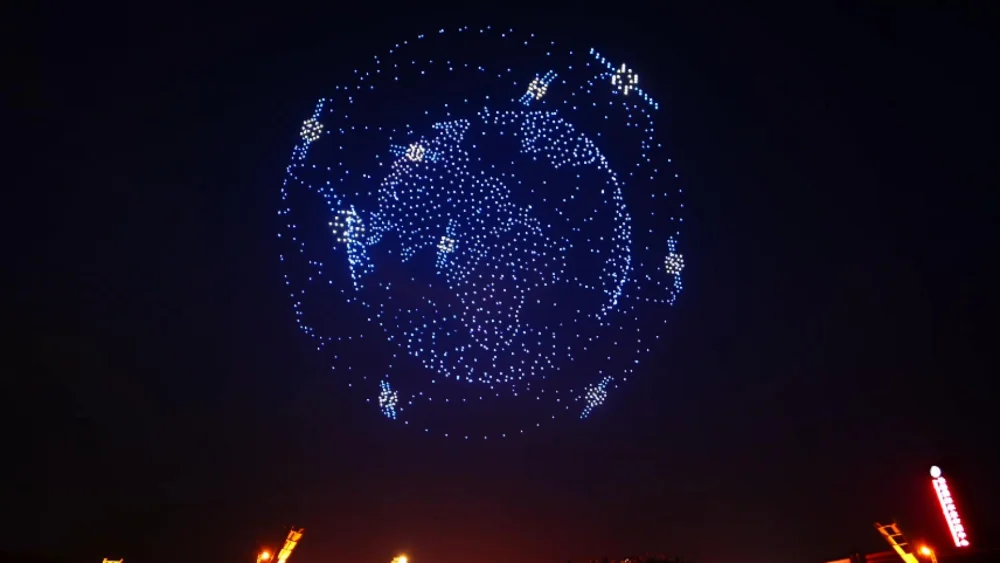Application of Creative 3D Drone Swarm Light Show in Commercial Performance
Drone light shows have changed our perception of aerial performances. Especially in commercial occasions such as concerts, product launches, sporting events and city festivals, drone swarms have become a cutting-edge medium for storytelling, brand promotion and audience interaction. In this blog post, Highgreat, as a high quality drone manufacturing company, will share the application of creative 3D drone swarm light show in commercial performance.
1. Understanding Drone Swarm Technology
At its core, a drone swarm light show involves the synchronized flight of dozens to thousands of unmanned aerial vehicles (UAVs), equipped with high-intensity RGB LEDs or pixel lighting systems. These drones are pre-programmed to follow a precise trajectory in three-dimensional space to create visual patterns, animations, and textual elements.
From a systems engineering perspective, a successful drone light show hinges on the integration of several key technologies:
* GNSS-based positioning systems (often RTK or PPK-enhanced GPS) for sub-centimeter location accuracy.
* Mesh communication networks that allow drones to receive real-time updates and perform decentralized coordination.
* Flight planning algorithms that optimize drone paths while ensuring safe distances and avoiding collision.
* Custom 3D animation and visualization software that converts creative content into executable flight commands.
2. The Creative Process: From Concept to Flight
The commercial application of drone swarms begins in the conceptual stage, where the goals of the performance are defined. These might include:
* Reinforcing a brand message (e.g., rendering a company logo or product silhouette).
* Enhancing an artist' s live performance with dynamic aerial choreography.
* Creating immersive experiences for event-goers through narrative-driven visuals.
Storyboarding and Design
The creative team collaborates with animators and drone software engineers to storyboard a sequence of scenes. Each visual element - say, a butterfly that morphs into a sneaker for a fashion brand launch - is sketched out in 3D animation tools such as Blender, Cinema 4D, or Autodesk Maya.
Flight Path Translation
Once visuals are finalized, software converts these designs into trajectory data. This involves creating motion curves for each drone, adjusting flight altitudes, and timing LED color changes. Specialized tools like DroneShow Software, SPH Engineering' s UgCS, or Intel' s proprietary platforms can automate much of this process.
Simulation and Safety Verification
Before a live performance, teams simulate the entire sequence in a virtual environment to identify any path conflicts, signal interference, or issues with battery duration. Safety margins, geofencing, and fail-safe mechanisms (e.g., automatic return-to-home) are embedded in the code to minimize risk during live execution.

3. Technical Components in Drone Light Show
Commercial drone light shows rely on a robust hardware and software stack. Key components include:
* Drone Hardware: Lightweight, customized quadcopters optimized for payload efficiency and aerodynamic stability. Typical drone models weigh less than 1.5 kg and are equipped with:
* High-luminance RGB LEDs.
* Lithium-polymer (LiPo) batteries with 15–20 minute flight time.
* Low-latency communication modules (e.g., XBee, LoRa).
* Ground Control Systems (GCS): These act as the central command hub, sending launch, position, and light-control commands to each drone. They also monitor telemetry in real-time.
* Localization Infrastructure: RTK base stations are deployed on-site to correct GPS drift, enabling precision within 2–3 cm, which is crucial for tight formation flying.
* Wireless Communication Protocols: Wi-Fi mesh, ZigBee, or proprietary 2.4GHz systems are used to maintain robust drone-to-drone and drone-to-ground communications, especially in environments with electromagnetic interference.
4. Real-World Applications in Commercial Performance
A. Product Launches
3D drone light shows are increasingly used in product unveilings for maximum spectacle and brand recall.
Technical Consideration: These events require precise real-time synchronization between the music score, product reveal, and drone flight sequence. Latency must be minimized to ensure alignment between audio-visual effects and drone movement.
B. Concerts and Music Festivals
Artists and event organizers integrate drone swarms into their stage design, using them as dynamic aerial backdrops or interactive "co-performers."
Creative Integration: Here, real-time responsiveness is key. Live control systems must allow operators to adapt drone behavior to the performance' s tempo, which often varies from rehearsed timings. AI-driven pattern generators and MIDI-synced flight controllers have been deployed for such adaptive scenarios.
C. Sports Events and Stadium Ceremonies
At major sporting events like the Olympics or Super Bowl, drones offer a novel way to display national symbols, mascots, or athlete names. Their ability to scale vertically and create complex 3D illusions - such as spinning globes or morphing flags - makes them ideal for grand ceremonies.
Safety Measures: Stadium events require additional scrutiny due to high population density. Redundant communication links, dedicated drone landing zones, and secure perimeter fencing are standard protocols. Additionally, fallback logic is embedded in drones to avoid crowd flyovers.
D. Corporate Events and Advertising Campaigns
Numerous brands have used drone swarms for large-scale advertising and PR campaigns. Animated logos, countdown timers, and promotional messages formed in the sky create viral content ideal for social media amplification.
Data Analytics: Post-event analytics can track social engagement and measure reach based on the drone show' s visual uniqueness and timing. Using drones as a medium not only creates live spectacle but also long-tail digital visibility.
Conclusion
3D drone swarm light shows perfectly blend technical sophistication with artistic expression, delivering unparalleled visual excitement, emotional impact, and branding opportunities. As innovation continues to advance, drone swarms are likely to become as ubiquitous in commercial events as LED screens and laser lighting. For companies and creators committed to pushing the boundaries of audience engagement, embracing drone swarms is not just an option, it' s the next logical step.

 Telephone No.Email
Telephone No.EmailMailbox number:marketing@hg-fly.com



